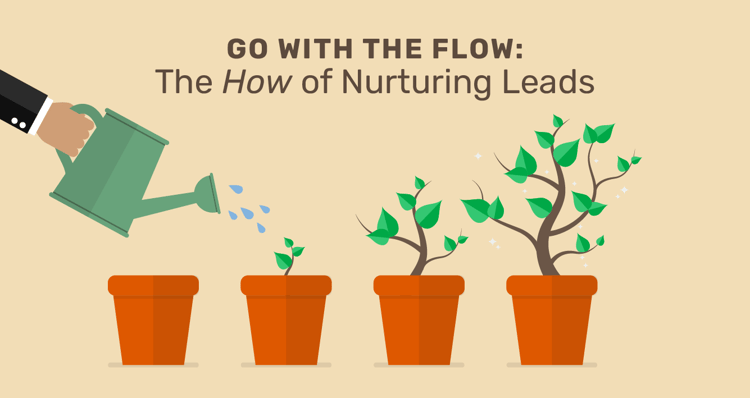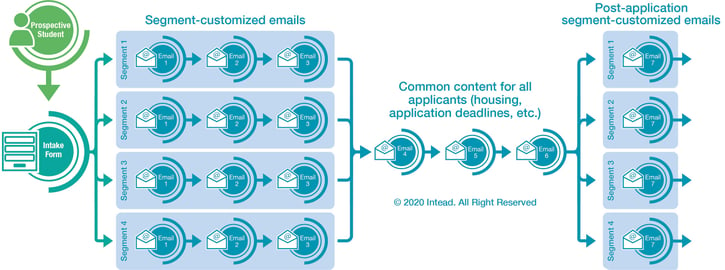
The first day of spring, for those of us in the Northern Hemisphere, is only 15 days away (not like we’re counting or anything.) Those few extra minutes of sunlight and that fresh feeling in the air got us thinking…about gardening. Taking our minds off the non-stop Coronavirus news.
With much of the spring international education conference circuit on hold, you just might catch us spending a bit more time in wide-brim straw hats with a gardening trowel. ; -)
But there IS something about the art of gardening — selecting the right plants, planting them in the right soil, providing them with the appropriate sunlight, water and food, that strikes a chord in our little marketing hearts.
Yes, we’re talking about nurturing.
If we consider your student leads as your fledgling flowers, how are you tending to them? Are you providing them with individualized care tailored to their needs? And, most importantly, are you guiding them towards a pathway to growth, or in our case, enrollment?
We’ve already discussed the power of segmenting your pool of student leads on this blog, as well as outlined different methods to segment in order to effectively develop content strategy around prospective students’ areas of interest. These posts are a few of our most read over time, getting consistent new readers each month.
Now, an important aside about email marketing...if you are among those who say, "Email is dead. Students don't read email." That may be because you are not putting any content in your email worth reading. We ALL delete useless sales emails on sight.
Reality Check (based on data): When a student prospect is engaged, they read your email. The onus is on you to engage them.
Segmentation is the first step to nurturing effectively, so make sure you have those defined audiences in place before you focus on today’s article: The How of Nurturing Leads. We’ll be offering you concrete suggestions for structuring email nurturing campaigns, as well as how to efficiently strategize your email topics and deliverables. Read on.
Getting Started: Content First
At the basic level, your email nurturing campaign should provide prospects with the right information, at the right time. You know this. As you connect with your students in-person and collect data through your website traffic, lead forms and CTAs, use this data to map your student journey for each of your defined audience segments.
Important distinction:
- It's about what do they really want to know, and when.
- NOT, what you really want to tell them and when.
Think about what type of information they need at each stage of their search and separate your email topics into upper, mid, and lower funnel engagement. As you strategize, consider emphasizing the human element of your campus and study experience. Alumni profiles, current student testimonials, campus events, and messages from faculty and administrators will show rather than tell your prospective students about how great you are. Think video. Think video alot. (Some of you think VR).
With these topics defined and a talented writer on call to execute, you are on your way to a successful nurturing campaign.
At the Annual Nafsa Conference last year in Washington, DC, Northeastern University Director of Global Recruitment Marketing and Enrollment Management Hillary Dostal and I presented on Student Micro-conversions -- The idea of having each communication bring your prospect another step forward in the decision process rather than pushing them to the "Apply Now" button every time you say "Hi". If you'd like the slides from that presentation, drop us a line (info@intead.com).
And if the thought of journey-mapping or drafting catchy subject lines sounds about as fun as a 10-hour flight next to a screaming baby, give us a call.
Structuring Your Messaging: Multi-Segment Flows
Wondering how your audience segmentation comes into play in all of this? No need to panic.
While segmenting can mean a scramble of disparate teams and departments requesting oversight and final approval of your email messaging (we’ve been there), you can quickly and easily build out focused student nurturing flows by establishing set topics. Think templates and efficiency across all of your audience segments to streamline information gathering and approval.
A simplified example: Consider each email in the diagram below as a topic grouping.
- Email 1 — Dean’s message
- Email 2 — Current student testimonial
- Email 3 — Alumni career story, etc.

While the exact content of each email topic might differ for each of your audience segments (e.g. a profile of a superstar Computer Engineering alumna making waves as a Product Manager at Instagram vs. an Architecture graduate designing Amazon’s new headquarters), the general subject area can remain the same, according to your templates.
Choosing to incorporate on-campus events or news highlights into your email flow for each segment (e.g. a CEO panel discussion for potential business students, an upcoming science expo for your STEM leads) can also help to establish a natural rapport with your leads and provide a closer look at the campus life experience. As an added bonus, you will likely already have approved promotional content for these types of events from your respective departments! Insert student name/program/event here.
Do consider the evergreen nature of these communications. Past stellar events are entirely valid as demonstrations of the types of things your institution does in a particular field. Upcoming events do not give you that "set and forget" usefulness. However, and this is a really important "however," the set and forget mentality that marketing automation famously touted eight-ish years ago is really no longer valid.
Set and forget now lasts about 6 months, at best, before a talented writer needs to go in and update, revise, refresh. Content is still king and fresh content is even kinger. (ouch, that's not really a phrase we want to coin!)
Back to segmentation...just because your email flows are segmented doesn’t mean they have to stay separated. Throughout the student journey these segmented email flows can converge and diverge, as there are some topics, such as student housing (Email 4), the application process (Email 5), or financial aid (Email 6), that will likely remain the same (or largely the same) across all of your audience segments.
If you’re getting a headache at just the thought of managing all of this email communication, know that all of this will be SO much easier with a good CRM and marketing automation platform. Looking to make some changes to your CRM? You can read our previous post on implementing a university CRM or download our full CRM Planning Guide through Intead Plus.
A Lead is Just a Lead (Unless You Nurture It)
At the end of the day, all of those great student leads you are capturing at events, fairs, and through your digital marketing efforts are of no use without a plan to engage and nurture them through to enrollment. With your thoughtful lead segmentation in place and highly relevant content tailored to each segment and stage of the student journey, you will be on your way to an effective email nurturing campaign that engages students throughout the funnel.
The onus is on you to engage them.
Nurture on, and watch your garden grow.


